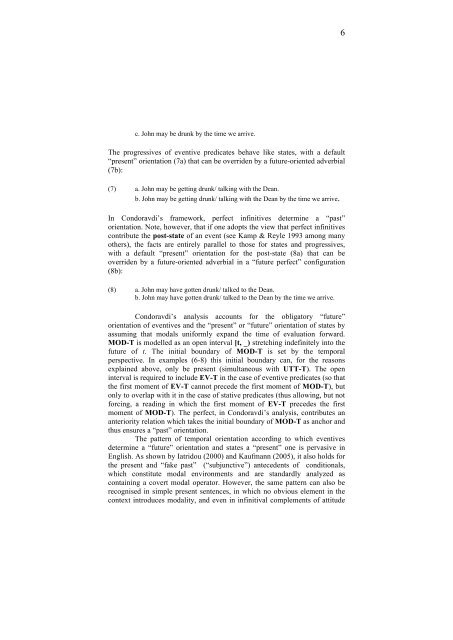On modal tenses and tensed modals - UMR 7023 - CNRS
On modal tenses and tensed modals - UMR 7023 - CNRS
On modal tenses and tensed modals - UMR 7023 - CNRS
You also want an ePaper? Increase the reach of your titles
YUMPU automatically turns print PDFs into web optimized ePapers that Google loves.
c. John may be drunk by the time we arrive.<br />
The progressives of eventive predicates behave like states, with a default<br />
“present” orientation (7a) that can be overriden by a future-oriented adverbial<br />
(7b):<br />
(7) a. John may be getting drunk/ talking with the Dean.<br />
b. John may be getting drunk/ talking with the Dean by the time we arrive.<br />
In Condoravdi’s framework, perfect infinitives determine a “past”<br />
orientation. Note, however, that if one adopts the view that perfect infinitives<br />
contribute the post-state of an event (see Kamp & Reyle 1993 among many<br />
others), the facts are entirely parallel to those for states <strong>and</strong> progressives,<br />
with a default “present” orientation for the post-state (8a) that can be<br />
overriden by a future-oriented adverbial in a “future perfect” configuration<br />
(8b):<br />
(8) a. John may have gotten drunk/ talked to the Dean.<br />
b. John may have gotten drunk/ talked to the Dean by the time we arrive.<br />
Condoravdi’s analysis accounts for the obligatory “future”<br />
orientation of eventives <strong>and</strong> the “present” or “future” orientation of states by<br />
assuming that <strong>modal</strong>s uniformly exp<strong>and</strong> the time of evaluation forward.<br />
MOD-T is modelled as an open interval [t, _) stretching indefinitely into the<br />
future of t. The initial boundary of MOD-T is set by the temporal<br />
perspective. In examples (6-8) this initial boundary can, for the reasons<br />
explained above, only be present (simultaneous with UTT-T). The open<br />
interval is required to include EV-T in the case of eventive predicates (so that<br />
the first moment of EV-T cannot precede the first moment of MOD-T), but<br />
only to overlap with it in the case of stative predicates (thus allowing, but not<br />
forcing, a reading in which the first moment of EV-T precedes the first<br />
moment of MOD-T). The perfect, in Condoravdi’s analysis, contributes an<br />
anteriority relation which takes the initial boundary of MOD-T as anchor <strong>and</strong><br />
thus ensures a “past” orientation.<br />
The pattern of temporal orientation according to which eventives<br />
determine a “future” orientation <strong>and</strong> states a “present” one is pervasive in<br />
English. As shown by Iatridou (2000) <strong>and</strong> Kaufmann (2005), it also holds for<br />
the present <strong>and</strong> “fake past” (“subjunctive”) antecedents of conditionals,<br />
which constitute <strong>modal</strong> environments <strong>and</strong> are st<strong>and</strong>ardly analyzed as<br />
containing a covert <strong>modal</strong> operator. However, the same pattern can also be<br />
recognised in simple present sentences, in which no obvious element in the<br />
context introduces <strong>modal</strong>ity, <strong>and</strong> even in infinitival complements of attitude<br />
6

















